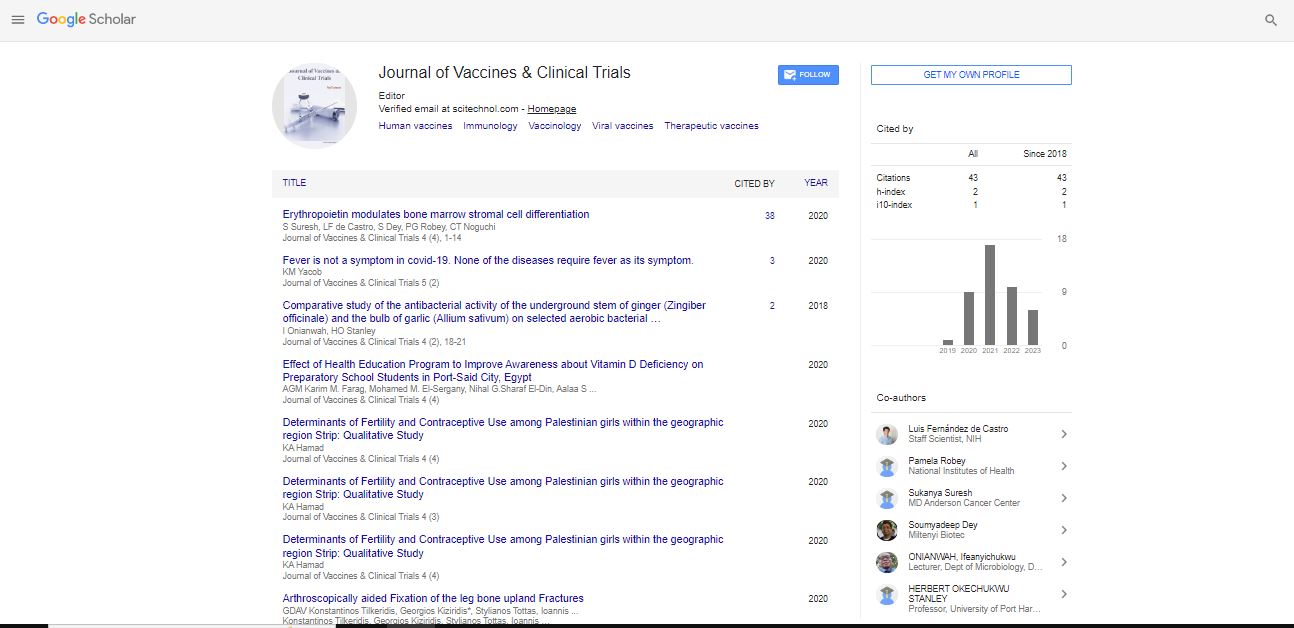Perspective, Jou Of Vac Cli Tr Vol: 7 Issue: 4
An Overview on Plague Disease: It's Diagnosis and Treatment Methods
Marques Rodrigues*
1Department of Pharmacology, Federal University of Pernambuco, Recife, Brazil
*Corresponding Author: Marques Rodrigues,
Department of Pharmacology,
Federal University of Pernambuco, Recife, Brazil
E-mail: Rodrigues.marques@ufpe.br
Received date: 27 November, 2023, Manuscript No. JVCT-24-128362;
Editor assigned date: 30 November, 2023, Pre QC No. JVCT-24-128362 (PQ);
Reviewed date: 07 December, 2023, QC No. JVCT-24-128362;
Revised date: 21 December, 2023, Manuscript No. JVCT-24-128362 (R);
Published date: 28 December, 2023 DOI: 10.4172/JVCT.100092
Citation: Rodrigues M (2023) An Overview on Plague Disease: It's Diagnosis and Treatment Methods. Jou of Vac Cli Tr 7:4.
Description
The Plague, one of the most infamous and devastating diseases in human history, has plagued civilizations for centuries, leaving an indelible mark on societies, economies, and cultures worldwide. Its impact, both immediate and long-term, reverberates throughout history, shaping medical practices, social structures, and even religious beliefs.
The plague primarily refers to the bubonic plague, caused by the bacterium Yersinia pestis. This disease typically manifests in three forms: bubonic, pneumonic, and septic emic. The bubonic plague, transmitted through the bite of infected fleas living on rodents, often resulted in swollen lymph nodes or "buboes" in the groin, armpit, or neck. Pneumonic plague affects the respiratory system, while septic emic plague infects the bloodstream, leading to severe sepsis.
The most infamous pandemic, known as the Black Death, struck Europe in the mid-14th century, causing unparalleled devastation. Originating in Asia, it spread through trade routes and reached Europe in 1347, rapidly sweeping across the continent. Estimates suggest that it wiped out in between 30% to 60% of Europe population within a few years. The sudden and widespread death caused societal upheaval, economic collapse, and cultural trauma, leaving a lasting impact on the fabric of medieval Europe.
The societal consequences of the Black Death were immense. Labor shortages arose due to the massive loss of life, resulting in a significant shift in power dynamics between the ruling class and the peasantry. The scarcity of workers increased demands for better wages and living conditions, leading to social unrest and revolts. Additionally, the sudden surplus of resources and property from the deceased led to changes in inheritance laws and land distribution.
Religious beliefs and practices were also deeply affected. The catastrophic loss of life challenged the prevailing religious ideologies, as people grappled with the question of why a benevolent God would allow such suffering. Some turned to religious extremism or sought solace in radical religious movements, while others questioned established beliefs, leading to shifts in religious thought and practice.
Efforts to combat the plague were initially futile due to limited medical knowledge and primitive healthcare systems. Quarantine measures, such as isolating the sick and restricting movement, were employed, but their effectiveness was limited. Traditional remedies and superstitions often prevailed, contributing to the spread of the disease rather than its containment.
However, the devastation caused by the Black Death also catalyzed advancements in medicine and public health. The need to understand and combat the plague led to the emergence of epidemiology as a field of study. Physicians and scientists began to document symptoms, transmission patterns, and attempted various treatments, laying the groundwork for future scientific inquiry into infectious diseases.
Subsequent outbreaks of the plague occurred periodically throughout history, known as "plague resurgences." While none were as catastrophic as the Black Death, these outbreaks continued to claim lives and disrupt societies. Notable outbreaks occurred in the 17th century, such as the Great Plague of London in 1665, and in the 19th and early 20th centuries in various parts of the world.
Today, the plague still exists in certain parts of the world, primarily in rural areas of Africa, Asia, and the Americas. However, due to modern healthcare practices, antibiotics, and better sanitation, it is more manageable and rarely reaches epidemic proportions. Prompt diagnosis and treatment remain crucial in preventing its spread and minimizing its impact on affected communities.
The plague stands as a harrowing reminder of the devastating power of infectious diseases throughout history. Its impact on societies, from the Black Death’s cataclysmic effects on medieval Europe to its enduring legacy on medicine and public health, underscores the importance of vigilance, research, and preparedness in the face of emerging infectious threats. The lessons learned from the plague continue to shape our understanding of diseases and influence efforts to combat them, emphasizing the on-going relevance of historical pandemics in shaping our present and future responses to global health challenges.
 Spanish
Spanish  Chinese
Chinese  Russian
Russian  German
German  French
French  Japanese
Japanese  Portuguese
Portuguese  Hindi
Hindi 